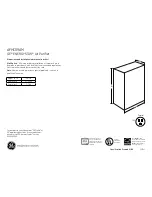
180
RT-SVX36G-EN
Maintenance
Important:
Do NOT release refrigerant to the atmosphere! If adding or removing refrigerant is
required, the service technician must comply with all federal, state, and local laws.
•
To prevent cross contamination of refrigerants and oils, use only dedicated R-410A service
equipment.
•
Disconnect unit power before evacuation and do not apply voltage to compressor while under
vacuum. Failure to follow these instructions will result in compressor failure.
•
Due to the presence of POE oil, minimize system open time. Do not exceed 1 hour.
•
When recharging R-410A refrigerant, it should be charged in the liquid state.
•
For the initial charging with the compressors off; charging to the liquid line is required to
minimize starting the compressors with liquid refrigerant in the compressor oil sump.
•
If suction line charging is needed to complete the charging process, only do so with the
compressor operating.
•
Allow the crankcase heater to operate a minimum of 8 hours before starting the unit.
Compressor Oil
The appropriate oil charge for a 7.5 ton scroll compressor is 6.3 pints. For 9 through 15 ton light
commercial scroll compressors is 7 pints. For a 15, 20 and 25 ton large commercial scroll
compressors (75 ton units), use 14.2 pints.
Scroll Compressor Replacements
Discoloration of the oil indicates that an abnormal condition has occurred. If the oil is dark and
smells burnt, it has overheated because of: compressor operating at extremely high condensing
temperatures; high superheat; a compressor mechanical failure; or, occurrence of a motor burnout.
If a motor burnout is suspected, use an acid test kit (KIT15496) to check the condition of the oil. Test
results will indicate an acid level has exceeded the limit if a burnout occurred. Oil test kits must be
used for POE oil (OIL00079 for a quart container or OIL00080 for a gallon container) to determine
whether the oil is acidic. If a motor burnout has occurred, change the oil in both compressors in
a tandem set.
NOTICE:
Compressor Damage!
In order to prevent compressor damage, you MUST follow recommendations below:
CSHD Compressors (20-70 & 80 Ton)
For CSHD compressors this will require that the oil
be removed using a suction or pump device through
the oil equalizer Rotolock fitting, see
. Use
a dedicated device for removing oil. It is good
practice to flush the suction device with clean oil
prior to use.
Place a catch pan under the oil equalizer Rotolock
connection fitting on the compressor to catch the oil
that will come out of the compressor when the oil
equalizer tube is removed from the compressor.
Prior to reinstalling the oil equalizer line to each
compressor, replace the PTFE gasket on the oil
equalizer Rotolock fitting on each compressor. See
. Torque Rotolock nut to the values
listed in
Figure 92. CSHD
Содержание IntelliPak SAHL Series
Страница 47: ...RT SVX36G EN 47 Installation Figure 16 Unit rigging Figure 17 Typical unit base and roof curb cross section...
Страница 65: ...RT SVX36G EN 65 Installation Figure 30 Hot Water Piping 90 130 Ton Figure 31 Steam Coil Piping 20 36 Ton...
Страница 86: ...86 RT SVX36G EN Installation Figure 38 Field connection diagram notes for 20 89 ton CV or VAV applications...
Страница 87: ...RT SVX36G EN 87 Installation Figure 39 Typical field wiring diagram for 20 89 ton VAV control option 2307 9177...
Страница 88: ...88 RT SVX36G EN Installation Figure 40 Typical field wiring diagram for 20 89 ton VAV control option...
Страница 173: ...RT SVX36G EN 173 Startup Checklists Figure 88 Dry bulb changeover map...
Страница 175: ...RT SVX36G EN 175 Maintenance Figure 89 Unit internal fuse replacement data for air handling units...
















































